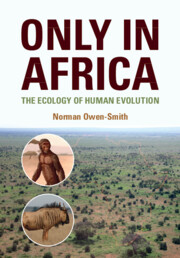Book contents
- Only in Africa
- Only in Africa
- Copyright page
- Dedication
- Contents
- Foreword
- Preface
- Abbreviations
- Part I The Physical Cradle: Land Forms, Geology, Climate, Hydrology and Soils
- Part II The Savanna Garden: Grassy Vegetation and Plant Dynamics
- Part III The Big Mammal Menagerie: Herbivores, Carnivores and Their Ecosystem Impacts
- Part IV Evolutionary Transitions: From Primate Ancestors to Modern Humans
- Chapter 15 Primate Predecessors: From Trees to Ground
- Chapter 16 Primate Ecology: From Forests into Savannas
- Chapter 17 How an Ape Became a Hunter
- Chapter 18 Cultural Evolution: From Tools to Art and Genes
- Chapter 19 Reticulate Evolution Through Turbulent Times
- Chapter 20 Prospects For a Lonely Planet
- Appendix Scientific Names of Extant Animal and Plant Species Mentioned in the Book Chapters (Ecologically Conservative with Regard to Species Recognition)
- Index
- References
Chapter 18 - Cultural Evolution: From Tools to Art and Genes
from Part IV - Evolutionary Transitions: From Primate Ancestors to Modern Humans
Published online by Cambridge University Press: 09 September 2021
- Only in Africa
- Only in Africa
- Copyright page
- Dedication
- Contents
- Foreword
- Preface
- Abbreviations
- Part I The Physical Cradle: Land Forms, Geology, Climate, Hydrology and Soils
- Part II The Savanna Garden: Grassy Vegetation and Plant Dynamics
- Part III The Big Mammal Menagerie: Herbivores, Carnivores and Their Ecosystem Impacts
- Part IV Evolutionary Transitions: From Primate Ancestors to Modern Humans
- Chapter 15 Primate Predecessors: From Trees to Ground
- Chapter 16 Primate Ecology: From Forests into Savannas
- Chapter 17 How an Ape Became a Hunter
- Chapter 18 Cultural Evolution: From Tools to Art and Genes
- Chapter 19 Reticulate Evolution Through Turbulent Times
- Chapter 20 Prospects For a Lonely Planet
- Appendix Scientific Names of Extant Animal and Plant Species Mentioned in the Book Chapters (Ecologically Conservative with Regard to Species Recognition)
- Index
- References
Summary
This chapter describes adaptive advances in cultural artefacts in the form of stone or bone tools and rock art and relates them to genetic linkages among local populations. The earliest Odowan cores and flakes gave way to bifacial Acheulian points and cleavers and later to finely crafted artefacts inaugurating the Middle Stone Age, associated with the emergence of modern humans. During the late Pleistocene further cultural advances were exhibited by inhabitants of coastal caves in the south-western Cape when the interior was largely uninhabited. The use of spear and arrow points fostered the movement out of Africa and may have contributed to extinctions among large grazers. Genomic evidence reinforces movements by language groups spreading herding and farming through Africa. Khoe-San and Hadza people retained the hunter-gatherer lifestyle into modern times. Rock art depicts the ritual significance of large mammals in their culture. African people lived alongside abundant wild herbivores until Europeans brought guns.
Keywords
- Type
- Chapter
- Information
- Only in AfricaThe Ecology of Human Evolution, pp. 301 - 328Publisher: Cambridge University PressPrint publication year: 2021

